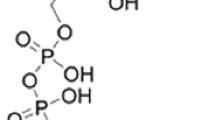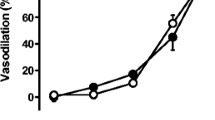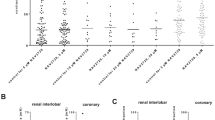Abstract
Receptors for purines and pyrimidines are expressed throughout the cardiovascular system. This study investigated their functional expression in porcine isolated pancreatic arteries. Pancreatic arteries (endothelium intact or denuded) were prepared for isometric tension recording and preconstricted with U46619, a thromboxane A2 mimetic; adenosine-5′-diphosphate (ADP), uridine-5′-triphosphate (UTP) and MRS2768, a selective P2Y2 agonist, were applied cumulatively, while adenosine-5′-triphosphate (ATP) and αβ-methylene-ATP (αβ-meATP) response curves were generated from single concentrations per tissue segment. Antagonists/enzyme inhibitors were applied prior to U46619 addition. ATP, αβ-meATP, UTP and MRS2768 induced vasoconstriction, with a potency order of αβ-meATP > MRS2768 > ATP ≥ UTP. Contractions to ATP and αβ-meATP were blocked by NF449, a selective P2X1 receptor antagonist. The contraction induced by ATP, but not UTP, was followed by vasorelaxation. Endothelium removal and DUP 697, a cyclooxygenase-2 inhibitor, had no significant effect on contraction to ATP but attenuated that to UTP, indicating actions at distinct receptors. MRS2578, a selective P2Y6 receptor antagonist, had no effect on contractions to UTP. ADP induced endothelium-dependent vasorelaxation which was inhibited by MRS2179, a selective P2Y1 receptor antagonist, or SCH58261, a selective adenosine A2A receptor antagonist. The contractions to ATP and αβ-meATP were attributed to actions at P2X1 receptors on the vascular smooth muscle, whereas it was shown for the first time that UTP induced an endothelium-dependent vasoconstriction which may involve P2Y2 and/or P2Y4 receptors. The relaxation induced by ADP is mediated by P2Y1 and A2A adenosine receptors. Porcine pancreatic arteries appear to lack vasorelaxant P2Y2 and P2Y4 receptors.










Similar content being viewed by others
Abbreviations
- αβ-meATP:
-
αβ-Methylene-adenosine-5′-triphosphate
- ADP:
-
Adenosine-5′-diphosphate
- ATP:
-
Adenosine-5′-triphosphate
- ENTPDase:
-
Ecto-nucleotidase 5′-triphosphate diphosphohydrolase
- PPADS:
-
Pyridoxal phosphate-6-azophenyl-2',4'-disulfonic acid
- UTP:
-
Uridine-5′-triphosphate
- VSMCs:
-
Vascular smooth muscle cells
- XAC:
-
Xanthine amine congener
References
Novak I (2008) Purinergic receptors in the endocrine and exocrine pancreas. Purinergic Signal 4(3):237–253
Burnstock G, Novak I (2012) Purinergic signalling in the pancreas in health and disease. J Endocrinol 213(2):123–141
Khakh BS, Burnstock G, Kennedy C, King BF, North RA, Séguéla P et al (2001) International union of pharmacology. XXIV. Current status of the nomenclature and properties of P2X receptors and their subunits. Pharmacol Rev 53(1):107–118
Abbracchio MP, Burnstock G, Boeynaems J-M, Barnard EA, Boyer JL, Kennedy C et al (2006) International union of pharmacology LVIII: update on the P2Y G protein-coupled nucleotide receptors: from molecular mechanisms and pathophysiology to therapy. Pharmacol Rev 58(3):281–341
Kasakov L, Burnstock G (1982) The use of the slowly degradable analog, α,β-methylene ATP, to produce desensitisation of the P2-purinoceptor: effect on non-adrenergic, non-cholinergic responses of the guinea-pig urinary bladder. Eur J Pharmacol 86(2):291–294
Burnstock G (2006) Pathophysiology and therapeutic potential of purinergic signaling. Pharmacol Rev 58(1):58–86
Kügelgen I (2008) Pharmacology of mammalian P2X and P2Y receptors. Biotrend Reviews, no. 3
Communi D, Govaerts C, Parmentier M, Boeynaems J-M (1997) Cloning of a human purinergic P2Y receptor coupled to phospholipase C and adenylyl cyclase. J Biol Chem 272(51):31969–31973
Qi A-D, Zambon AC, Insel PA, Nicholas RA (2001) An arginine/glutamine difference at the juxtaposition of transmembrane domain 6 and the third extracellular loop contributes to the markedly different nucleotide selectivities of human and canine P2Y11 receptors. Mol Pharmacol 60(6):1375–1382
Léon C, Hechler B, Vial C, Leray C, Cazenave J-P, Gachet C (1997) The P2Y1 receptor is an ADP receptor antagonized by ATP and expressed in platelets and megakaryoblastic cells. FEBS Lett 403(1):26–30
Bodor ET, Waldo GL, Hooks SB, Corbitt J, Boyer JL, Harden TK (2003) Purification and functional reconstitution of the human P2Y12 receptor. Mol Pharmacol 64(5):1210–1216
Marteau F, Le Poul E, Communi D, Communi D, Labouret C, Savi P et al (2003) Pharmacological characterization of the human P2Y13 receptor. Mol Pharmacol 64(1):104–112
Waldo GL, Harden TK (2004) Agonist binding and Gq-stimulating activities of the purified human P2Y1 receptor. Mol Pharmacol 65(2):426–436
Nicholas RA, Lazarowski ER, Watt WC, Li Q, Boyer J, Harden TK (1996) Pharmacological and second messenger signalling selectivities of cloned P2Y receptors. J Auton Pharmacol 16(6):319–323
Carter RL, Fricks IP, Barrett MO, Burianek LE, Zhou Y, Ko H et al (2009) Quantification of Gi-mediated inhibition of adenylyl cyclase activity reveals that UDP is a potent agonist of the human P2Y14 receptor. Mol Pharmacol 76(6):1341–1348
Coutinho-Silva R, Parsons M, Robson T, Lincoln J, Burnstock G (2003) P2X and P2Y purinoceptor expression in pancreas from streptozotocin-diabetic rats. Mol Cell Endocrinol 204(1–2):141–154
Hillaire-Buys D, Chapal J, Petit P, Loubatières-Mariani M-M (1991) Dual regulation of pancreatic vascular tone by P2X and P2Y purinoceptor subtypes. Eur J Pharmacol 199(3):309–314
Hillaire-Buys D, Dietz S, Chapal J, Petit P, Loubatieres-Mariani MM (1999) Involvement of P2X and P2U receptors in the constrictor effect of ATP on the pancreatic vascular bed. Journal de la Societe de Biologie 193(1):57–61
Alsaqati M, Chan SLF, Ralevic R (2011) Characterisation of the response to ADP in porcine isolated pancreatic arteries. http://www.pa2online.org/abstracts/vol8issue1abst028p.pdf. Accessed 22 April 2013
Rayment SJ, Ralevic V, Barrett DA, Cordell R, Alexander SPH (2007) A novel mechanism of vasoregulation: ADP-induced relaxation of the porcine isolated coronary artery is mediated via adenosine release. FASEB J 21(2):577–585
Kügelgen I, Häussinger D, Starker K (1987) Evidence for a vasoconstriction-mediating receptor for UTP, distinct from the P2 purinoceptor, in rabbit ear artery. Naunyn Schmiedeberg’s Arch Pharmacol 336(5):556–560
Ralevic V, Burnstock G (1991) Effects of purines and pyrimidines on the rat mesenteric arterial bed. Circ Res 69(6):1583–1590
Rubino A, Burnstock G (1996) Evidence for a P2-purinoceptor mediating vasoconstriction by UTP, ATP and related nucleotides in the isolated pulmonary vascular bed of the rat. Br J Pharmacol 118(6):1415–1420
Korchazhkina O, Wright G, Exley C (1999) Intravascular ATP and coronary vasodilation in the isolated working rat heart. Br J Pharmacol 127(3):701–708
Ralevic V, Burnstock G (1996) Relative contribution of P2U- and P2Y-purinoceptors to endothelium-dependent vasodilatation in the golden hamster isolated mesenteric arterial bed. Br J Pharmacol 117(8):1797–1802
Zimmermann H (2000) Extracellular metabolism of ATP and other nucleotides. Naunyn Schmiedeberg’s Arch Pharmacol 362(4–5):299–309
Stanford SJ, Mitchell JA (1998) ATP-induced vasodilatation in the rat isolated mesenteric bed exhibits two apparent phases. Br J Pharmacol 125:94P
Ralevic V (2001) Mechanism of prolonged vasorelaxation to ATP in the rat isolated mesenteric arterial bed. Br J Pharmacol 132(3):685–692
Ralevic V (2002) The involvement of smooth muscle P2X receptors in the prolonged vasorelaxation response to purine nucleotides in the rat mesenteric arterial bed. Br J Pharmacol 135(8):1988–1994
Burnstock G, Williams M (2000) P2 purinergic receptors: modulation of cell function and therapeutic potential. J Pharmacol Exp Ther 295(3):862–869
Burnstock G (2007) Purine and pyrimidine receptors. CMLS 64(12):1471–1483
Ko H, Carter RL, Cosyn L, Petrelli R, de Castro S, Besada P et al (2008) Synthesis and potency of novel uracil nucleotides and derivatives as P2Y2 and P2Y6 receptor agonists. Bioorg Med Chem 16(12):6319–6332
Hartley SA, Kato K, Salter KJ, Kozlowski RZ (1998) Functional evidence for a novel suramin-insensitive pyrimidine receptor in rat small pulmonary arteries. Circ Res 83(9):940–946
Miyagi Y, Zhang JH (2004) α,β-Methylene ATP enhances P2Y4 contraction of rabbit basilar artery. Am J Physiol Heart Circ Physiol 286(4):H1546–H1551
Qasabian RA, Schyvens C, Owe-Young R, Killen JP, Macdonald PS, Conigrave AD et al (1997) Characterization of the P2 receptors in rabbit pulmonary artery. Br J Pharmacol 120(4):553–558
Miyagi Y, Kobayashi S, Nishimura J, Fukui M, Kanaide H (1996) Dual regulation of cerebrovascular tone by UTP: P2U receptor-mediated contraction and endothelium-dependent relaxation. Br J Pharmacol 118(4):847–856
Knight GE, Oliver-Redgate R, Burnstock G (2003) Unusual absence of endothelium-dependent or -independent vasodilatation to purines or pyrimidines in the rat renal artery. Kidney Int 64(4):1389–1397
Mombouli JV, Vanhoutte PM (1993) Purinergic endothelium-dependent and -independent contractions in rat aorta. Hypertension 22(4):577–583
Wong SL, Leung FP, Lau CW, Au CL, Yung LM, Yao X et al (2009) Cyclooxygenase-2-derived prostaglandin F2alpha mediates endothelium-dependent contractions in the aortae of hamsters with increased impact during aging. Circ Res 104(2):228–235
Dol-Gleizes F, Mares AM, Savi P, Herbert JM (1999) Relaxant effect of 2-methyl-thio-adenosine diphosphate on rat thoracic aorta: effect of clopidogrel. Eur J Pharmacol 367(2–3):247–253
Alefishat E, Alexander S, Ralevic V (2010) Effect of palmitoyl CoA on ADP-evoked vasorelaxations in porcine isolated coronary and mesenteric arteries. http://www.fasebj.org/cgi/content/meeting_abstract/24/1_MeetingAbstracts/lb426. Accessed 22 April 2013
Schulte G, Fredholm BB (2003) Signalling from adenosine receptors to mitogen-activated protein kinases. Cell Signal 15(9):813–827
Chapal J, Loubatieres-Mariani MM (1983) Evidence for purinergic receptors on vascular smooth muscle in rat pancreas. Eur J Pharmacol 87(4):423–430
Satoh A, Shimosegawa T, Satoh K, Ito H, Kohno Y, Masamune A et al (2000) Activation of adenosine A1-receptor pathway induces edema formation in the pancreas of rats. Gastroenterology 119(3):829–836
Nguyen NC, Taalab K, Osman MM (2010) Decreased blood flow with increased metabolic activity: a novel sign of pancreatic tumor aggressiveness. Clin Cancer Res Off J Am Assoc Cancer Res 16(1):367, 567
Acknowledgments
We would like to thank Damascus University in Syria for funding the project.
Author information
Authors and Affiliations
Corresponding author
Rights and permissions
About this article
Cite this article
Alsaqati, M., Chan, S.L.F. & Ralevic, V. Investigation of the functional expression of purine and pyrimidine receptors in porcine isolated pancreatic arteries. Purinergic Signalling 10, 241–249 (2014). https://doi.org/10.1007/s11302-013-9403-2
Received:
Accepted:
Published:
Issue Date:
DOI: https://doi.org/10.1007/s11302-013-9403-2




